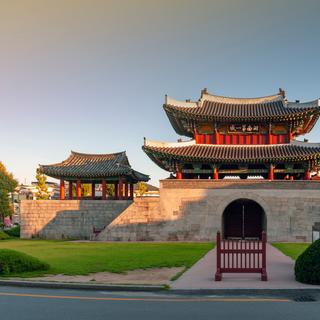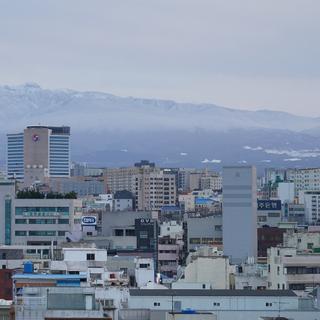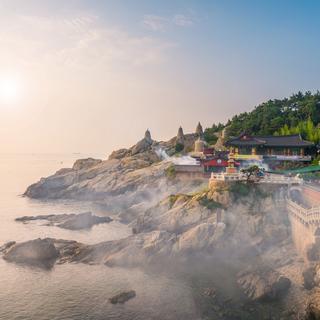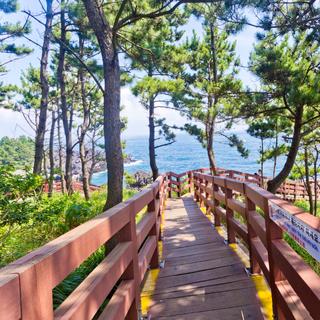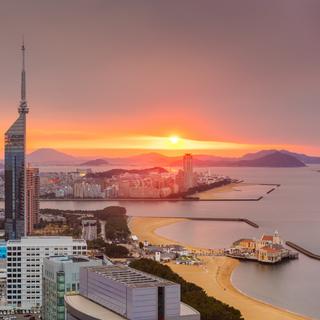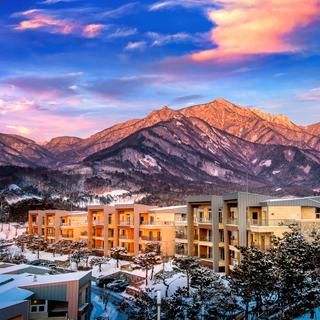Gwangju weather and climate in 2025
Day
7 °C
Night
-1 °C
Sea
13 °C
Precipitation
32 mm
in month
Rainy days
7 days
in month
Daylight
10 hours
average
Sunshine
5 hours
average
Humidity
75 %
Weather charts for Gwangju
Find more destinations like this
Closest destinations for Gwangju
Closest cities for Gwangju
Weather overview for Gwangju
Weather overview
Gwangju (South Korea) is a place with a mild continental climate. The day temperatures range from 4 °C (40 °F) in January to 30 °C (87 °F) in August. The driest month is October with just 6 days of rain, on the contrary, the month when it rains the most is July with 15 days of rain. Temperatures during the night go from -4 °C (26 °F) in January to 23 °C (73 °F) in August.
January weather
The night temperature is on its minimum, with its value of -4 °C (26 °F) in Gwangju, and the minimum of the day temperature is observable as well, its value is 4 °C (40 °F).
February weather
The beginning of the rise of the rainfall amount could be noticed, with its value being 44 mm (1.74 in) in Gwangju. The day temperature starts to rise, the value of this measure is 7 °C (45 °F), and the night temperature starts to rise as well, the value of this measure is -2 °C (28 °F). The beginning of the rise of the number of sun hours (without clouds) could be noticed, with its value of 6 hours.
March weather
The day temperature continues to rise, with its value of 13 °C (55 °F) in Gwangju, and the rise of the night temperature can be observed as well, with its value being 2 °C (35 °F). The rise of the number of sun hours (without clouds) can be observed, with its value of 7 hours. The rainfall amount continues to rise, the value of this measure is 61 mm (2.40 in). The minimum of the humidity can be noticed in this month. The maximum of the wind speed can be noticed in March.
April weather
The day temperature continues to rise in Gwangju, and the rise of the night temperature can be observed as well, with its value of 7 °C (45 °F). The tourist season is at its beginning in April. The number of sun hours (without clouds) continues to rise, with its value being 7 hours. The rainfall amount continues to rise, with its value of 84 mm (3.32 in).
May weather
The day temperature rises similarly to the previous month, its value is 24 °C (75 °F) in Gwangju, and the night temperature rises similarly to the previous month too, the value of this measure is 13 °C (55 °F). There is pending tourist season this month. The rainfall amount continues to rise, with its value of 98 mm (3.87 in). The number of sun hours (without clouds) is on its maximum in May.
June weather
The rise of the day temperature can be observed, with its value of 27 °C (81 °F) in Gwangju, and the rise of the night temperature can be observed as well, its value is 18 °C (64 °F). The number of rainy days starts to rise, the value of this measure is 10 days, while the rainfall amount rises similarly to the previous month, its value is 173 mm (6.83 in). The tourist season is close to its peak. The number of sun hours (without clouds) starts to descent, with its value of 7 hours.
July weather
The wet season slowly starts in Gwangju. The number of rainy days is on its maximum, with its value of 15 days, and the rainfall amount reaches its maximum too, with its value of 298 mm (11.71 in). The day temperature rises similarly to the previous month, with its value of 29 °C (85 °F), and the rise of the night temperature can be observed too, with its value being 23 °C (73 °F). The maximum of the humidity is observable, the value of this measure is 82 %.
August weather
The day temperature reaches its maximum, its value is 30 °C (87 °F) in Gwangju, and the night temperature reaches its maximum too, with its value of 23 °C (73 °F). The beginning of the descent of the number of rainy days could be noticed, with its value being 14 days, and the rainfall amount descent's start could be observed as well, the value of this measure is 273 mm (10.75 in). The wet season continues. The number of sun hours (without clouds) rise's start could be observed.
September weather
The tourist season is about to start in Gwangju. The number of rainy days descents similarly to the previous month, and the descent of the rainfall amount can be observed too, with its value of 147 mm (5.79 in). The beginning of the descent of the day temperature could be noticed, its value is 26 °C (79 °F), and the night temperature descent's start could be observed too in September. The number of sun hours (without clouds) descent's start could be observed in September.
October weather
The tourist season is taking place in Gwangju. The day temperature continues to descent, its value is 21 °C (70 °F), and the night temperature descents similarly to the previous month as well, its value is 11 °C (51 °F). The number of rainy days is on its minimum, its value is 6 days, while the descent of the rainfall amount can be observed, the value of this measure is 53 mm (2.09 in). The minimum of the wind speed can be noticed, with its value being 2.
November weather
The number of rainy days rise's start could be observed in November in Gwangju. The descent of the day temperature can be observed, and the night temperature descents similarly to the previous month as well, the value of this measure is 4 °C (39 °F). The number of sun hours (without clouds) starts to descent, with its value being 5 hours.
December weather
The minimum of the rainfall amount is observable, its value is 32 mm (1.26 in) in Gwangju. The descent of the day temperature can be observed, with its value being 7 °C (45 °F), and the night temperature continues to descent as well, with its value of -1 °C (29 °F). The minimum of the day length can be noticed, the value of this measure is 10 hours. The minimum of the number of sun hours (without clouds) can be noticed, the value of this measure is 5 hours.
FAQs
How humid is Gwangju in March?
Humidity in March in Gwangju is 69 %.
Are there good conditions to visit in Gwangju in April?
There are good conditions for visiting in April in Gwangju. You can expect just 8 days of rain during the month, taking an umbrella is not necessary. There are some people, who may feel a slight chill at 19 °C (67 °F), but others will feel perfectly fine. The temperature of 7 °C (45 °F) at night may make it better to dine inside or to put on more clothes for a dinner outside.
What temperature can I expect during the day in May in Gwangju?
In May in Gwangju, the average daily temperatures will be 24 °C (75 °F). A comfortable temperature for most people, where it is neither too cold nor too hot, and a large number of activities can be carried out comfortably, including sunbathing by the water. Lighter clothing will be suitable - shorts, skirts, t-shirts, jackets; a light sweater and long trousers may also be useful.
What is the sea temperature in June in Gwangju?
In June in Gwangju expect the sea to be warm at 19 °C (66 °F). At this sea temperature, swimming probably won't be the best experience. You probably won't like to stay in water for a long time. On the other hand, there are a minority of people who seek these conditions.
How many sunny hours can I expect in Gwangju in July?
In Gwangju in July, you can expect around 6 hours of sunshine.
What is the night temperature in August in Gwangju?
The average night temperature in August in Gwangju is 23 °C (73 °F). A very pleasant temperature for long evening walks, fun over a drink outside, or doing sports in the morning. If possible, look for a hotel with air conditioning.
Is it hot in Gwangju in September?
In September in Gwangju, you will enjoy nice warm weather, but it will also be pleasant and you probably won't feel hot.
Is there a wet season in Gwangju in October?
No, there is no wet season in Gwangju in October - you can expect 6 days of rain during the month.
How many rainy days can I expect in Gwangju in November?
In November in Gwangju, we can expect 8 days to be rainy, that is, days when precipitation exceeds 2 mm (0.08 in). Converted to days of the week, this means that it will occur on an average of 1.8 days of the week, or in general - 26 % days.
We make the most from 40 years of historical weather data to predict the best weather conditions.
Deciding on where to go for a holiday is hard sometimes. Get inspired by the most popular destinations.
We aggregate data from combining multiple weather sources to ensure accuracy of the highest order.
